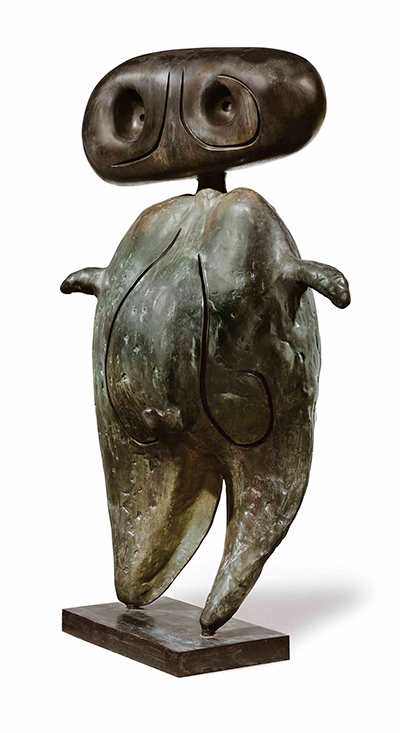Personnage was conceived and cast by Joan Miro in 1970. Several iterations were produced at the same time, and then numbered as appropriate on the back alongside the artist's signature.
The artist here would create a Neolithic god-like figure within his own world, which was far removed from reality. Miro believed that sculpture actually offered him the chance to get closer to what he wanted to produce, because of the nature and opportunities found within the third dimension, as opposed to the paintings for which he remains more famous. When looking at Personnage, we immediately spot the short, unfeasibly wide head with two eyes gauged into the bronze. Tiny arms are then added and all the limbs remind us of the undeveloped paddles that Miro often used within his figurative sculptures. From behind this sculpture you will notice an opening down the spine which then reveals the empty centre of the piece. The sculpture was then attached to a simple, modest plinth, perhaps underlining how several of these were produced at the same time.
Miro also scored long lines into the back of the head which adds another feeling of being into a different world or universe. The casts were all around two metres in height, making them entirely suitable for displaying indoors or outdoors, whereas later sculptures by this artist started to become more and more ambitious, with Dona i Ocell being over 20 metres tall. Miro was always call upon the assistance of others when working outside of his comfort zone of painting, but at the same time would remain hands-on in order to ensure that what was produced in his name was entirely as he had planned. He would therefore oversee the casting of each sculpture and kept a close eye on proceedings. This also had the advantage of providing further documentation for each individual piece, which would bear his own signature.
Personnage is an enjoyable venture into sculpture by Miro and works well at the size that he chose to make it. The details are relatively simple, but impactful and the bronze casting left a smooth finish to this design. Miro wa always seeking new worlds within his work, but in this case suggested that this figure represents the reality of humankind, rather than the version that we see everyday. He was often attracted to themes of cosmology and elements of that would then appear and re-appear across different mediums, not just sculpture. It is said that he was one of the few artists to have genuinely succeeded in a wide number of mediums and this reminds us of his versatility.




